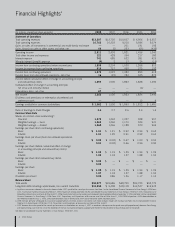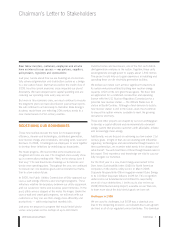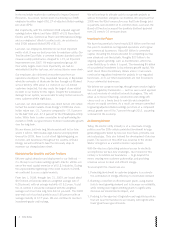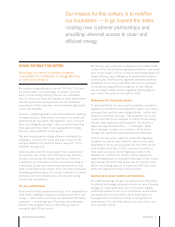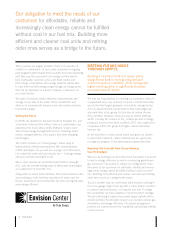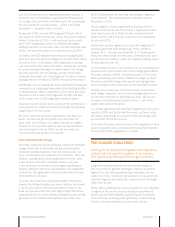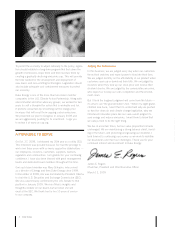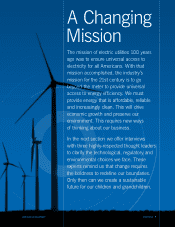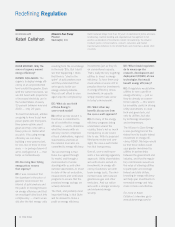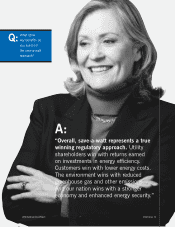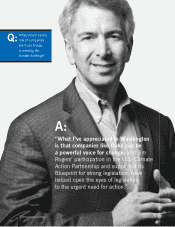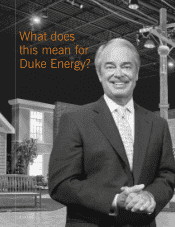Duke Energy 2008 Annual Report Download - page 14
Download and view the complete annual report
Please find page 14 of the 2008 Duke Energy annual report below. You can navigate through the pages in the report by either clicking on the pages listed below, or by using the keyword search tool below to find specific information within the annual report.
12 Duke Energy
DUKE ENERGY: Why the
sense of urgency around
energy efficiency?
KATERI CALLAHAN: The
urgency to deploy energy effi-
ciency at an unprecedented
level couldn’t be greater. Even
with the current recession, we
are still faced with projections
of increased electricity use in
the United States of nearly
30 percent between now and
2030 — only 22 years.
To meet that demand, utilities
are going to have to put new
power plants into their plans.
New power options aren’t
great and they come with a
heavy price no matter what
you pick. If by using energy
efficiency we can delay
building a new power plant,
for one, two or three or more
years — or perhaps forever if
we’re really good at it — that
helps us tremendously.
DE: Do rising then falling
energy prices remove
that urgency?
KC: I was concerned that
the downturn in the price of
gasoline would lessen the
interest of policymakers and
the public in moving forward
on energy efficiency and that
we would get lulled back into
complacency — much as we
did after the first energy crisis
resulting from the oil embargo
in the early ’80s. But I don’t
see that happening. I think
that there is “steel in the
spine” of policymakers now
and they understand that
we’ve got to tackle our
energy-related problems.
We just can’t afford to once
again slip into complacency.
DE: What do you think
of Duke Energy’s
save-a-watt model?
KC: What we like about it is
that Duke is committed to
do all cost-effective energy
efficiency — and to determine
what that means with an
advisory council comprised
of local stakeholders, regional
stakeholders and folks at
the national level who are
committed to energy efficiency.
The second thing is that
Duke has agreed through
its model, and through a
memorandum of under-
standing with us and other
national stakeholders, to invest
in state-of-the-art evaluation,
measurement and verification
programs to ensure that the
promised energy savings are
actually delivered.
The third, and probably most
important thing, is that Duke
will be allowed to make a
profit on energy efficiency
investments just as they do
on conventional capacity.
That’s really the key to getting
utilities to invest in energy
efficiency. To have them only
made whole or worse still to
penalize them for investments
in energy efficiency versus
investments in capacity
simply doesn’t make sense
in today’s environment.
DE: What other key
benefits do you see from
the save-a-watt approach?
KC: In many of the energy
efficiency programs being
undertaken around the
country, there’s not as much
transparency as we would
like to see. With its proposed
third-party review and over-
sight, the save-a-watt model
has that transparency.
Overall, save-a-watt repre-
sents a true winning regulatory
approach. Utility shareholders
win with returns earned on
investments in energy effi-
ciency. Customers win with
lower energy costs. The envi-
ronment wins with reduced
greenhouse gas and other
emissions. And our nation
wins with a stronger economy
and enhanced energy
security.
DE: What should regulators
do to encourage the
research, development and
deployment (RD&D) of new
technologies that would
benefit energy efficiency?
KC: If regulators would allow
utilities to earn a profit on
energy efficiency — just as
they do already on conven-
tional capacity — this would
be incredibly useful in driving
utility investments in clean
tech and green tech, not
only by utilities, but also
by technology developers
and entrepreneurs.
The Alliance to Save Energy
is also pushing hard at the
federal level to double federal
investment in energy effi-
ciency RD&D. My hope would
be that those dollars could
spur greater investment by
utilities in partnerships
between the government and
industry, and that the regula-
tory commissions would see
the value of allowing utilities
to participate and leverage
federal and state dollars.
Investing in energy efficiency
will help spur investments in
renewable energy and help
make it more cost-effective.
For more of Kateri
Callahan’s interview, go to
www.duke-energy.com/ar.
Redefining Regulation
An interview with
Kateri Callahan
Alliance to Save Energy
President
Washington, D.C.
Kateri Callahan brings more than 20 years of experience in policy advocacy,
fundraising, coalition building and organizational management to her
position as president of the Alliance. Under her leadership, the Alliance
conducts policy, communications, research, education and market
transformation initiatives in the United States and more than a dozen other
countries.


